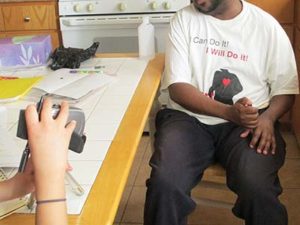Overcoming Recruiting Challenges to Inform Medical Device Development
That Was Easy!

Research has long been a cornerstone capability and offering at Insight. However, our clients face the constant reality that recruiting facilities and participants can be a real challenge. One that can significantly delay progress or even derail the project completely. Co-founder and Sr. Partner Craig Scherer is here talking with our Research and Strategy Director and our Director of Human Factors about overcoming recruiting challenges to inform medical device development.


Craig: We are fortunate as a design firm to be consulting in a time where the value of ethnography and research in general is well understood in medical device development. Despite this, recruiting remains a consistent challenge for us and our clients. Between complying with the Sunshine Act and the Health Insurance Portability and Accountability Act (HIPAA), and frankly, wading through miles of institutional red tape have made scheduling site visits to healthcare facilities and with health care providers a real obstacle. However, for us to be able to provide real insight intounmet and undeserved user needs, we have to be able to gain access to clinical sites, HCPs, and even patients.I’m here with our Director of Research and Strategy Carolyn Rose and our Director of Human Factors Michael Lau to talk a little more about this issue.
So, one way that our clients have combated patient recruitment challenges is through the use of Key Opinion Leaders(KOLs). Michael and Carolyn, what are your thoughts on the use of KOLs to access critical information?

Michael: Well Craig, KOLs can be an extremelyvaluable resource in any development program.
They typically have extensive expertise in the medical specialty and
device category of interest and have vision for where the field is
heading. Having a KOL on board from the start goes a long way toward
getting the team up to speed quickly and offering “gut check feedback”
throughout the research and design process. However, there are some
issues with them as primary source of information.

Carolyn: Yes, the problem is, they’re only one voice. They’re most likely highly skilled at this particular specialty and have developed patterns and behaviors that don’t necessarily translate across all users especially less experienced ones. So their being able to provide feedback on the variability of workflows and techniques can be a real issue. Their opinions can be a little biased toward the frequent and experienced user and this can be a problem, as the FDA specifically calls out the need for the evaluative and usability research to be performed on the intended user, of which there will be a range.
Craig: Ok, so Carolyn, it seems like a common strategy for recruiting for in-context research is to work through the client’s sales reps and marketing network. Does this work?

Carolyn: Absolutely, this can be a very effective means to recruit – particularly for observational research in clinical environments. Leveraging existing client relationships can reduce lead times and in some cases provide unfettered access.The reality, however, is that every customer network has limitations. It may not be able to deliver the number or variation of facilities or specialties required to satisfy the study. We also have many clients who prefer studies be double blinded, which is particularly challenging to pull off if the client makes first contact with the target location. But like a lot of challenges, recruiting must be thought of as a multivariable equation with client networks being one potential component.
Another resource we use on virtually every program is to tap into third party recruiting networks. We have multiple partners both here in the US as well as the EU and South East Asia. We have worked together with these organizations to optimize this process, streamlining the “red tape” required to gain access. Hospital credentialing has also helped with this, as aspects such as HIPAA compliance and infection control/ aseptic technique have become standardized training modules. Staying current with these requirements helps facilitate access.
Craig: Ok, so I think you’ve saved the best for last in this multi-variable equation. I know we’re all excited here at Insight about developing our own network of hospitals and clinical sites that we can tap into for research. It all started by doing research at a great little community hospital just 10 minutes from our office. We had done several studies with them and found out that even though they’re a stand alone hospital, they were part of a much larger purchasing coop. So Carolyn, what’s the plan for utilizing this group for our recruiting process?
Carolyn: Craig you are absolutely right, we’re all very excited about this new system! We’re working very closely with the organization that manages this entire group of hospitals. In working with this team, we have access to roughly 25 different US medical institutions – ranging from community hospitals to IDNs – as candidate participants for observational studies.
I think what we’re most excited about is that this network will allow us to work through the process much quicker and with greater specificity. By taking care of much of the logistical, operational and legal work upfront, we can better identify targets and expedite access.
So yeah, we’re excited!
Craig: Michael, we do roughly half our business in med device and the other half in pharmaceutical delivery systems, what are some of the biggest patient recruitment challenges that you have come across on the HF side, especially within Pharma?

Michael: Yeah, Pharma is certainly not without its recruiting challenges. When our Human Factors Engineers are doing usability studies for delivery devices, we often conduct them in our facility here in Chicago. Most of our delivery system usability work is done with patients and nurses and we typically do not find the recruits for common diseases to be that challenging. However, this year alone, we have done several studies within the rare disease category. There are over 30,000,000 Americans suffering from a rare disease. This is defined as a disease that has fewer than 200,000 patients. In fact, some of our studies have had patient populations in the couple hundreds! So the patient recruitment challenges are obvious.
This means we have to get creative with the recruit while still executing the study rigor that the FDA requires. Here are some of the questions we ask ourselves in order to recruit in pharma.
Can we tap into Patient Advocacy Groups? These are groups established to support patients in these low population groups. They can often refer us to clinicians who specialize in the disease and even directly recruit patients themselves.
Can we use Proxies? This means using patients with limitations, symptoms and device requirements to those of our target disease state. The FDA allows patients with similar characteristics to be used as substitutes – to uncover core usability and safety issues.
And finally, what are the effects on the study if we loosen the recruiting criteria? The more variables, the more difficult the recruit. Are they really required and do we need to rationalize the change in criteria in our HF submission to the FDA?
Craig: Carolyn and Michael, thanks for your insights on overcoming patient recruitment challenges for both our medical and drug delivery clients in research and human factors studies. At the end of the day, the real value we provide is our ability to conduct expert research and deliver exceptional outputs that help drive effective design and support our clients’ regulatory strategies. So, overcoming recruiting challenges with a multifaceted approach allows us to do what we are hired for…providing exceptional research outputs and findings. So when the recruiting is done, and we are off and running, we just want to hear our clients say…that was easy!

